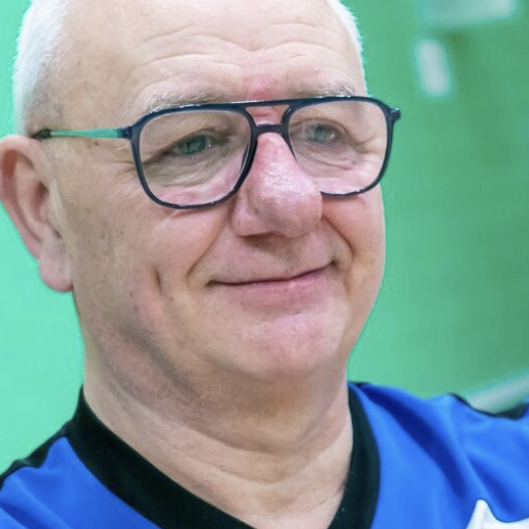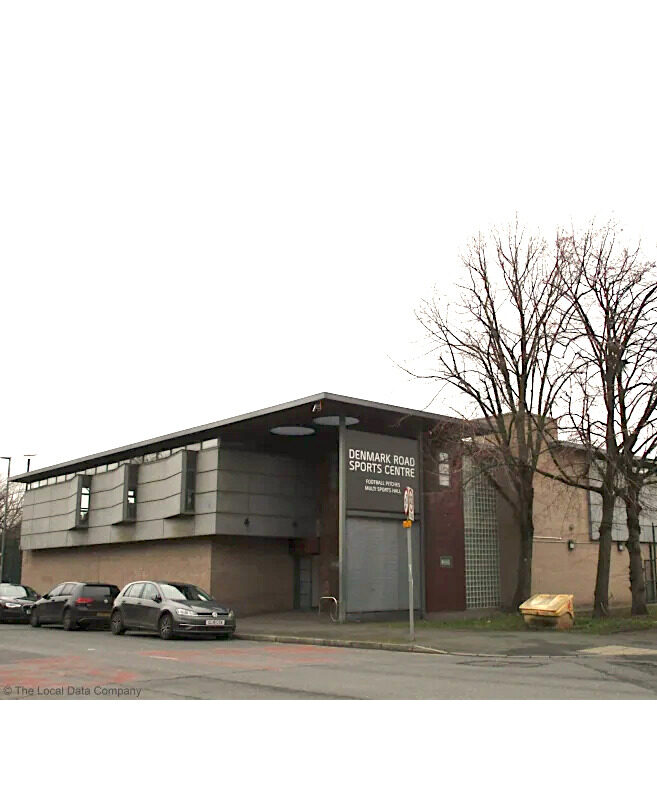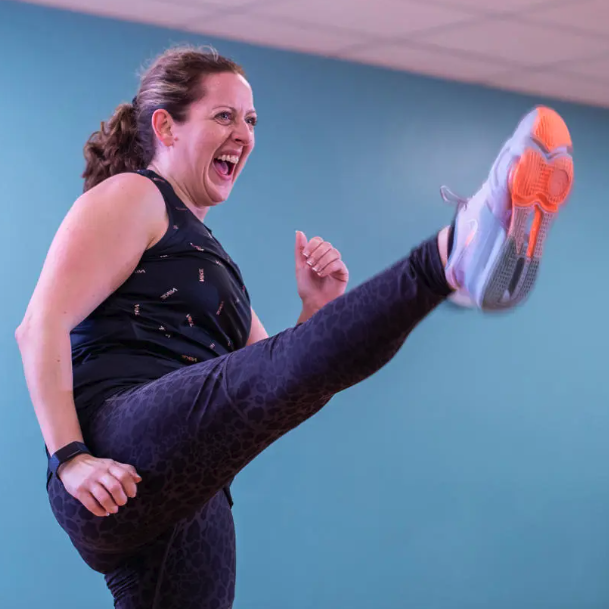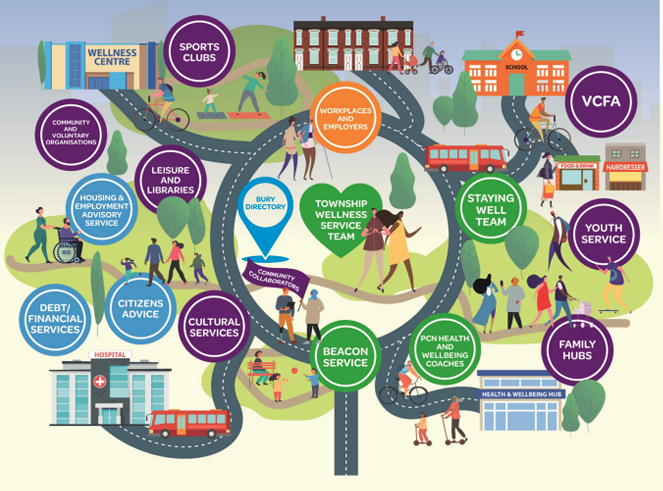This case study was developed as part of the SLC’s work on the GM Active Pivot to Active Wellbeing strategy aiming to address health inequalities through the transformation of public leisure services.
Your Trust, the leisure operator in Rochdale, recognised that it could play an important role in the recovery of stroke survivors, funding a programme called ‘Moving on After Stroke’.
It aimed to provide stroke survivors with information relating to anything that may have affected them after a stroke. This included nutrition, wellbeing, emotional state/mental health, finance and job-related information.
It also included weekly exercise sessions led by an Exercise After Stroke-qualified instructor to work on improving physical ability. It was available at Rochdale Leisure Centre and online, via live stream. The work of the programme is best explained through the story of a stroke survivor, Alan Phipps.

Alan joined the Moving On After Stroke sessions at Rochdale Leisure Centre to help with his recovery from a stroke in April 2019. Despite all leisure centres closing during the Covid-19 pandemic, this did not stop Alan.
He continued to attend the weekly sessions that had been moved online. He also joined another online group. Throughout lockdown, he started walking outdoors and got back to his 10,000 steps a day on a regular basis.
As leisure centres started to re-open, Alan embraced more of what was available from Your Trust.
He started swimming, attended a nutrition and wellbeing course and started back at face-to-face gentle exercise sessions.
He completed a 10-week functional fitness course and attended a pilot learning course, which enabled him to learn more about health and wellbeing and how to help others who are living with long term conditions.
Alan now volunteers on the falls prevention programme that Your Trust runs and helps others to get their confidence back.
Alan joined the Moving On After Stroke sessions at Rochdale Leisure Centre to help with his recovery from a stroke in April 2019. Despite all leisure centres closing during the Covid-19 pandemic, this did not stop Alan.
He continued to attend the weekly sessions that had been moved online. He also joined another online group. Throughout lockdown, he started walking outdoors and got back to his 10,000 steps a day on a regular basis.
As leisure centres started to re-open, Alan embraced more of what was available from Your Trust. He started swimming, attended a nutrition and wellbeing course and started back at face-to-face gentle exercise sessions.
He completed a 10-week functional fitness course and attended a pilot learning course, which enabled him to learn more about health and wellbeing and how to help others who are living with long term conditions. Alan now volunteers on the falls prevention programme that Your Trust runs and helps others to get their confidence back.
A key learning point has been that neurological specialist instructors are needed, qualified in Exercise After Stroke to run these sessions. An understanding of stroke symptoms and side effects is critical.
The future of Moving On after Stroke was in doubt when the Stroke Association’s funding came to an end in 2020.
However, Your Trust has kept the weekly sessions going online and encourages service users to access mainstream provision at its leisure centres.
Six of the attendees from the 2020 course still attend online sessions each week and several others now attend sessions at their local leisure centre.
Elaine Stott, Your Trust Active Community Development Coordinator, said: “Alan’s story is an inspiration to anyone who thinks they are being held back by a long-term condition.
“He always takes the time to talk to people and reassure them that he knows how they are feeling. He tells them that they can do it because he felt the same once and he has done it.
“He embraces everything with a great level of enthusiasm. The combination of all activities that Alan got involved with provided help in all aspects of his recovery and rehabilitation.
“Moving on After Stroke was a first step and provided a strong base of support and knowledge from which to move forwards and attend other sessions.”
This case study was developed as part of the SLC’s work on the GM Active Pivot to Active Wellbeing strategy aiming to address health inequalities through the transformation of public leisure services.
Denmark Road Leisure Centre (often just referred to as Denmark Road) in Manchester – serving Ardwick, Hulme, Moss Side and Rusholme – presented an opportunity to transition tradition.
There’s lots of talk about transitioning leisure assets from fitness to wellness.
The attempt here was to move towards a more responsive, needs-led, service-led model embedded as part of a whole system.
The concept was ‘spaces that are just spaces’. This means that spaces in the venue could be what they need to be for each resident, whether that’s where someone plays football, where someone meets their link worker or where someone attends a mindfulness workshop.
From the start – the council’s leisure team, MCRactive and its operating partner, GLL, worked with community health providers and services to create a health hub at Denmark Road.

Seventeen organisations came together in a series of workshops and two key themes emerged:
The organisations that signed up and co-designed the hub have acted on their intentions of creating a space for genuine collaboration and partnership working.
Significantly, a local GP practice has located some of its services at Denmark Road including its social prescribing and wellbeing teams.
Partnership meetings are held every six weeks and allows partners to share learning and provide an update on their services.
The initial investment from MCRactive was £20k. This was used to purchase office furniture, cover the desk rental for 11 of the 17 organisations for the first 12 months, and for a series of workshops / events to integrate the organisations.
While it’s difficult to have a clear indicator of success, there have been multiple collaborative projects, events and campaigns that wouldn’t have happened without the Denmark Road health hub.
Funding has been the biggest challenge for this project.
Towards the end of the first year, several organisations pulled out as they couldn’t self-fund for year two, and priorities changed.
It has also been difficult to replicate: similar schemes at Manchester Institute of Health and Performance (MIHP) and Wythenshawe Forum were proposed but couldn’t get traction.
The key success factors have been the diversity and shared ambition of the originations to work collaboratively and learn together.
Setting up the project was relatively straightforward as during the post-Covid period there was a strong appetite for working collaboratively. Being a funded project was also helpful.
This is still very new and evolving project. There is a lot more potential and learning to support the transition from leisure and fitness to active wellbeing.
This case study was developed as part of the SLC’s work on the GM Active Pivot to Active Wellbeing strategy aiming to address health inequalities through the transformation of public leisure services.
Health inequalities in Bury are stark. Men’s life expectancy can vary by 15 years depending on where they live, while for women it’s 11 years. Bury needed something radical. Transformation was the answer.
The Wellness Strategy is Bury’s approach to improving health outcomes and tackling health inequalities in the borough.

 The Bury Wellness Strategy
The Bury Wellness StrategyIn two adjacent wards, Sedgley and Radcliffe, men’s life expectancy varies by some 15 years. For women, there is nearly 11 years life expectancy difference between the Radcliffe and Summerseat wards.
These sorts of inequalities are deeply entrenched and have not been solved by traditional approaches and interventions.
This meant that a wide range of partners needed to come together with members of the community to define the problems and co-create new ways of working.
This challenge was made harder by the council’s need to find £30m of annual savings. So, the pressure was on from two directions: health need and financial need. This could only be addressed by true transformation.
There were no shortcuts in developing the Bury Wellness Strategy. It required a range of partners to talk, share and collaborate. They began to understand the problems in the borough, the causes, potential solutions and new ways of working.
The agreed vision (see figure 1) was to provide both a universal offer and a targeted offer, with the latter focused on the most deprived communities. Solutions would be developed in partnership with residents in those communities.
An integral part of this work was the development of the relationship and contract with Public Health.
Public Health commissions the Live Well service to provide health trainers and exercise referral officers. They offer one-to-one support for behaviour change on issues such as stopping smoking, movement and weight management.
Live Well is also working with a federation of three Primary Care Networks (PCNs) who will be using funding from the Additional Role Reimbursement Scheme (ARRS) to recruit eight full-time equivalent Health & Wellness Coaches to focus on cardiovascular risk factors, bowel screening, frailty and falls.
This will be delivered via a drop-in service to improve the accessibility for users.
It will be followed-up via small groups sessions which are more efficient than one-to-ones.
Measuring the success of the strategy is an ongoing challenge. On one hand, there is plenty of quantitative data about input measures such as numbers of people seen or the number of interventions.
But on the other hand, there is currently no data on impact. The council is currently looking at tools such as Cost Benefit Analysis and Social Return on Investment to demonstrate the impact and the financial savings that can be made through a preventative approach.
But there’s also a need to win over hearts and minds via human stories – a qualitative perspective. To address this, the council has created a series of person-centred case studies and a high-quality video which captures ‘on the ground’ stories of partners and local residents.
However, a key learning has been that partnership working, place-based working and a whole systems approach is not easy. It requires hard work: listening, explaining, influencing, shaping and planning. But in doing so it has created a positive, can-do attitude among partners with a high level of trust and an expectation that everyone plays their part.